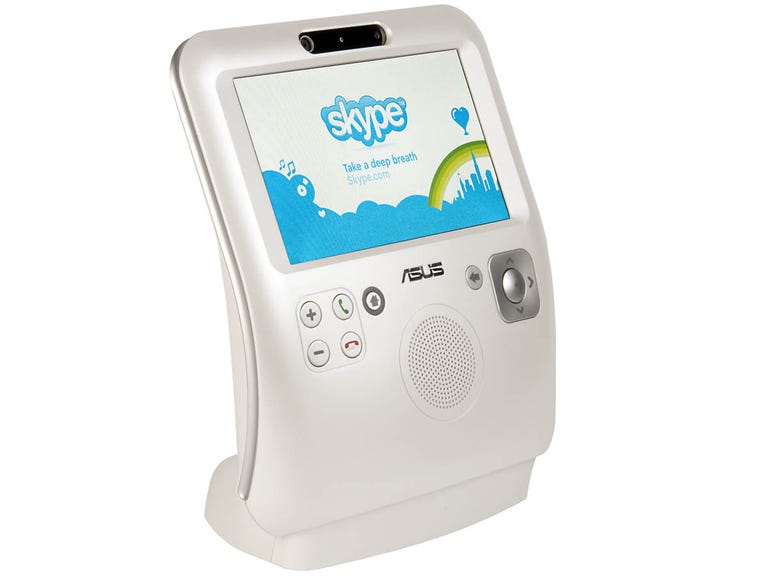 Why You Can Trust CNET
Why You Can Trust CNET Asus Videophone Touch AiGuru Sv1T review: Asus Videophone Touch AiGuru Sv1T
If you're a regular Skyper, the Asus Videophone Touch might tickle your fancy. It's a touchscreen device that lets you make video calls from your Skype account, without the need for a computer. Easy to use and solidly built, it is on the pricey side though -- is it really that much better than just using a netbook?
If you've spent any time abroad, or if you have family overseas, chances are you've signed up to Skype, the free online phone and chat service. If you're a regular Skyper, you might be interested in the Asus Videophone Touch -- a static touchscreen device that lets you make video calls from your Skype account, without the need for a computer. At around £200 from eXpansys, it's definitely on the pricey side though -- so is it really that much better than just using a netbook?
The Good
The Bad
The Bottom Line
Fat-bottomed gadget
We can't say the Videophone Touch is much of a looker. You can choose an off-white gloss or a dark grey shade, and with its chunky, rounded build it looks rather old-fashioned. We'd define the look as 'fax-machine chic'. It's surprisingly heavy, and is definitely not designed to ever leave the house. On the front panel you'll find a speaker, as well as a range of large buttons. Along the top of the Videophone Touch there's a microphone, and the all-important webcam.

Setup is impressively simple. The Videophone Touch can connect via Wi-Fi (or Ethernet cable if you wish), and once you're signed in to your home network the only thing left to do is sign in with your Skype login, entering your username and password via the touchscreen interface. We found the 7-inch TFT-LCD touchscreen to be responsive, and didn't notice any inaccuracy or failure to register inputs during our testing.
Interface-to-face
If you're put off by the fairly complicated interface of the computer-based Skype, you'll certainly appreciate the pared-down interface on show here. Once you're signed in you'll be presented with the main menu. This is surprisingly simple, with options to add contacts, browse your existing contacts, change your status and tinker with your account settings. The intuitive nature of the menu layout means that from switching the Videophone Touch on to actually making a call takes under a minute, without getting bogged down in menu navigation.
Call quality is high, coming through the front speaker loud and clear. If you're not happy with it, or want more privacy, there are 3.5mm sockets round the back where you can plug in headphones and a microphone.
The webcam produces a reasonably high quality picture for your caller, but like many webcams it struggles in low light. Still, once connected you're unlikely to have any trouble getting your message across.
The Videophone Touch is a bulky beast, and is probably best suited to sitting somewhere in your house rather than being moved around. Nevertheless, there's a lithium-ion battery hidden in the base. Asus claims you'll get around 20 minutes talk time or 30 minutes standby running off the battery, and our tests found that to be quite accurate. It's not much, but we could see it being useful for changing rooms mid-conversation, or giving your contacts a video tour of your house.
Omission impossible
Not every feature you'd find on Skype's computer-bound interface has survived the transition -- the biggest omission being chat. A huge part of the fun and functionality of chatting over Skype is the ability to share links, pictures, videos and so on. If your friends attempt to message you while you're signed in on the Videophone Touch, they'll receive a message back informing them you're using a mobile device and may not be able to receive messages.
There's also no option to top up your Skype account from the Videophone Touch. You have to pay to dial out to mobiles and landlines, but if you want to add credit you'll have to head over to the Skype Web site, which slightly defeats the object of being detached from a computer.
The biggest problem for the Videophone Touch is that it's very expensive. For £217 you could buy a netbook with a built-in webcam and a cheap headset -- a Skype-capable device that's also mobile and offers chat functions, plus a browser, email and everything else netbooks are useful for.
Conclusion
The Asus Videophone Touch is great at what it does. The call and video quality is impressive, and the experience is intuitive and fast. If you have elderly relatives who don't get on with computers, this might be a good option.
Unfortunately, the price is so high that unless you really feel like you couldn't use Skype on a computer, it's impossible to recommend the Videophone Touch over a laptop and headset. If that's something that appeals to you, check out the similarly priced Eee PC 901.
Editor's note: A previous version of this review had an incorrect score as the result of an editing error. It has now been corrected to reflect the author's intention.
Edited by Nick Hide


